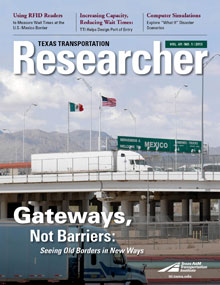The world is changing.

Used to be, national borders had one purpose: to act as a line a nation didn’t dare cross unless that nation wanted a war. Today — with the Internet cross-pollinating cultures between countries at the speed of light and a global economy dependent on streamlined international trade — national borders are more complex. Their demarcation of sovereign boundaries remains, of course, but their rigidity has softened.
Agencies that protect our national borders now have two seemingly conflicting tasks: facilitate international trade and the movement of people while ensuring national security. There’s an old adage in industry that “you can have it accurate, cheap or fast — pick any two.” Border protection agencies often face equal demands for all three, an especially difficult task in an era when government resources are becoming ever more scarce.
Transportation cuts across both missions. Moving goods internationally requires connectivity. The longer a product waits to cross the border, the more it costs its manufacturer (and, ultimately, its consumer). But products also have to move safely, legally and without threatening a nation’s security. Making sure the box contains what it says it does takes time. Trucks idle in long lines, waiting for assessment and polluting the air of border towns.
There’s no single solution to such complex problems. The Texas A&M Transportation Institute (TTI) has undertaken a number of research projects to help agencies figure out how improving the transportation factor of the border equation can help them fulfill both missions.
How can technology help producers more efficiently schedule freight shipments to avoid those long lines of idling trucks? The converse question: how can we improve border security without adding to wait times? And, to encourage cross-border consumerism, can we combine discrete travel resources for citizens to access when planning their trips? You’ll find answers to these questions in this issue.
In February, TTI published the 2012 Urban Mobility Report, the national standard for assessing traffic congestion levels in the United States. Not surprisingly, we’re sitting longer in traffic during rush hour, and the report offers some suggestions for mitigating that. Another project looks at avoiding congestion during natural disasters, a lesson El Paso learned the hard way in 2006. Other stories look at different aspects of our transportation network, like safety and resource management, which in some way impact the bottom line.
Also in this issue, we begin profiling members of our TTI Advisory Council. Please take a moment to learn about these outstanding individuals. Every one of our council members is an expert on some aspect of transportation, and TTI is lucky to have them guiding our agency into the future.
In some ways that future will feel familiar, but in many it will be very different. How we view our borders is likely to be one of those differences. How we manage our borders will also need to change as our economic and cultural barriers become more permeable and interconnected.
History has shown us that a vital, viable transportation network is key to national — and now international — growth. I have no doubt the future will prove that lesson true.

